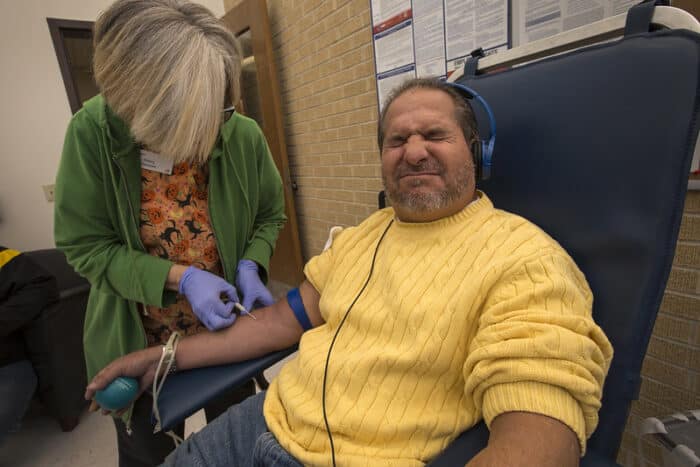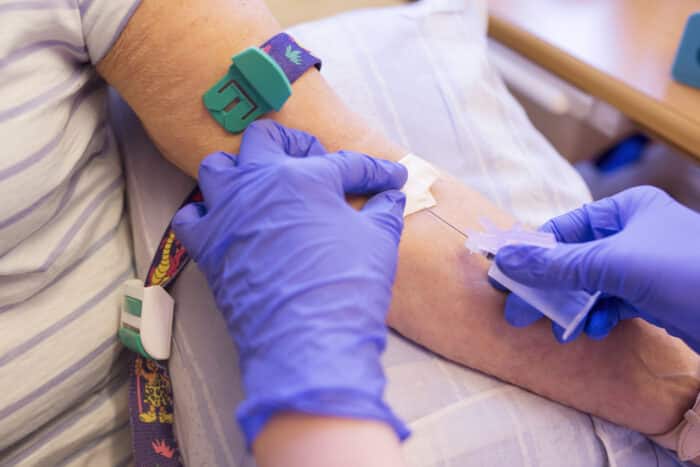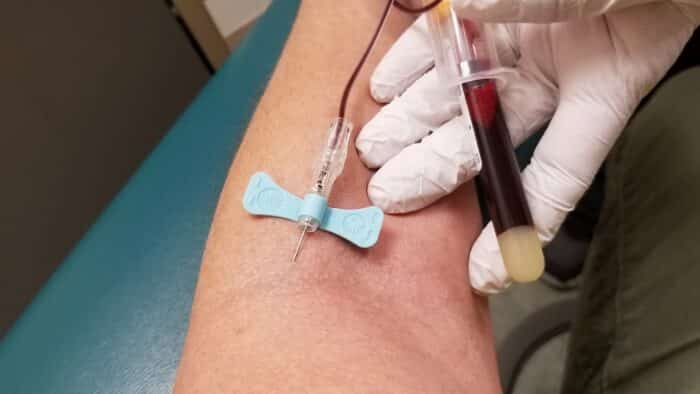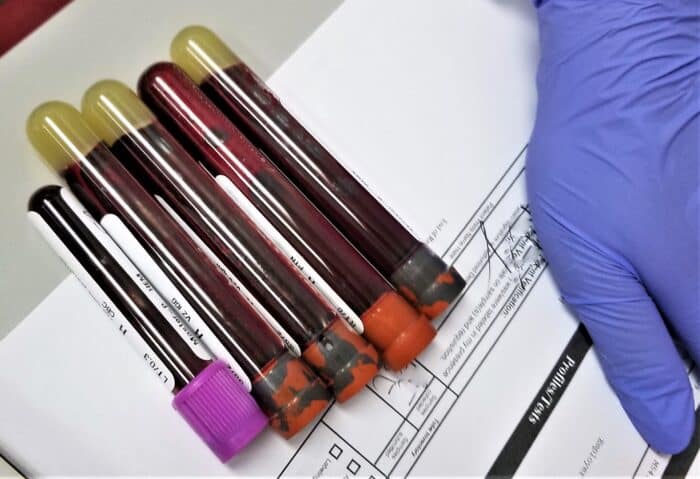Is helping people while having a job that allows you to travel possible?
And is such a job possible in the healthcare industry?
If you have ever wondered about these questions, we’re here to tell you that such a job is definitely possible.
The answer is pursuing a career in phlebotomy and becoming a traveling phlebotomy.
This rewarding career is also the best since you do not need a degree, just your high school diploma to become one.
So you can become an important healthcare team member while also being able to travel. Sounds good, right?
In this article, we aim to uncover more about traveling phlebotomists, who they are, what they do, how to become one, and so on.
Let’s dive right in.
What is a Traveling Phlebotomist?
Traveling phlebotomists are known as trained and qualified healthcare workers who specialize in drawing blood from patients.
The difference between a traveling and a regular phlebotomist is that traveling phlebotomists travel to the patient to collect the blood samples, instead of the other way around.
These locations can include different areas such as the patient’s home, workplace, school, nursing home, or sometimes even rural or remote areas.
A traveling phlebotomist is known to be the backbone of the healthcare team, as it brings healthcare to the patient who might find it inaccessible.
As the name suggests, the primary duty of a traveling phlebotomist is to draw and send blood samples from patients.
Apart from that, traveling phlebotomists also need to keep patient medical records, maintain their equipment, and provide emergency help whenever needed.
Read more on What is a Phlebotomist here.
How to Become a Traveling Phlebotomist
Now that you know what a traveling phlebotomist is and what they do, you might be wondering how to become one.
Let us help you with that.
Here is a step-by-step guide on how to become a traveling phlebotomist:
1. Complete your high school diploma or a GED.
Even though you typically do not need a degree to pursue becoming a phlebotomist, the minimum prerequisite is to finish your high school diploma or a GED.
2. Complete an accredited training program.
The first step toward becoming a traveling phlebotomist is to choose and enroll in the right phlebotomist training program.
There are two methods by which you can complete your training, by enrolling in a certificate program, or online/local classes.
While choosing a program best suited for you, ensure that the course is accredited by a nationally recognized institution or authority.
Read: Online Phlebotomist Classes
3. Gain Experience.
After you complete your educational training, the next step is to gain practical experience and put your knowledge and skills to use in a real-world setting.
You can do this through internships or externships, and a few training programs also provide externship opportunities after you complete their course.
Also see: Which Two Skills are Important for a Phlebotomist?
4. Get Certified.
Even though getting certified as a phlebotomist is not required except in a few states, employers still highly prefer candidates who are certified over uncertified ones.
A certification shows your competence and passion for the field, and hence it is always recommended.
There are three main certifying organizations that you can check out if you want to get certified as a phlebotomist, such as the American Society for Clinical Pathology (ASCP), the American Medical Technologists (AMT), and the National Healthcareer Association (NHA).
Also see: Phlebotomy Certification
5. Get a CPR/BLS Certificate.
Phlebotomists are generally required to obtain a BLS (Basic Life Support) certification by some employers. This typically includes CPR (cardiopulmonary resuscitation) techniques, among others.
The American Heart Association (AHA) offers a BLS CPR certificate course, which can be beneficial to complete for phlebotomists as it helps with enhancing job prospects.
6. Apply for Traveling Phlebotomist Jobs.
Congratulations! Now that you’re a certified phlebotomist, apply, prepare, and ace those job interviews.
Also see: How to Become a Phlebotomist

Do You Want To Become a Phlebotomist? Check Out Free Phlebotomist Masterclass!
In our masterclass you learn:
- How to be a Phlebotomist faster…in just 2 months!
- Avoid student debt & driving to classes
- #1 thing employers want from Phlebotomists
- How to stand-apart & get a university certificate for a strong resume
Skills Required to Become a Traveling Phlebotomist
If you’re still here, you might be interested in becoming a traveling phlebotomist and wondering what skills are required to become one.
Let us answer that.
Apart from having the proficiency to deal with drawing blood and handling blood samples, here are some key skills that are required to become a successful traveling phlebotomist-
- Attention to detail-
Paying attention to detail is an important aspect of phlebotomy to avoid any mistakes in labeling and handling blood specimens.
- Good communication skills-
Empathy and excellent communication skills are also necessary for Traveling Phlebotomists as they interact with different types of patients on a daily basis.
- Time management skills-
Time management is an important skill to have for managing schedules and reaching multiple locations on time, ensuring timely appointments and patient care.
- Problem-solving skills-
This helps Traveling Phlebotomists handle different challenges like difficult venipuncture or uncooperative patients while maintaining professionalism.
- Organizational skills-
Being organized is important for managing paperwork, records, and proper labeling and tracking of specimens.
- Knowledge of health and safety protocols-
Health and safety awareness is extremely important for phlebotomists to minimize any risks of infection during blood collection by following proper infection control practices.
- Driver’s license-
Having a driver’s license and good driving skills are essential for Traveling Phlebotomists who need to travel between locations.
- Reliability-
The ability to work independently is important as Traveling Phlebotomists often work with minimal supervision, requiring self-motivation and effective task and schedule management.
Also see: Phlebotomist Skills
How Much Does a Traveling Phlebotomist Earn?
After learning what traveling phlebotomists do, the skills required and how to become one, how much they earn must be your next thought.
According to the U.S. Bureau of Labor Statistics (BLS), the average annual salary of a phlebotomist is $37,380, or $17.97 per hour.
It is important to emphasize that the above-mentioned figures are highly dependent on a variety of influencing factors, such as job location, experience, and certifications.
Additionally, the BLS also states that the job outlook for phlebotomists looks positive for the next few years, with a 10% expected job growth, which is much higher than other professions.
See more: Phlebotomist Salary
What is the Difference Between a Mobile Phlebotomist and a Traveling Phlebotomist?
Both the terms ‘mobile phlebotomist’ and ‘traveling phlebotomist’ may sound similar and are often used interchangeably, however, there are some differences between the two job roles.
Mobile and Traveling Phlebotomists are both healthcare professionals who draw blood samples from patients outside traditional medical facilities, by traveling to the patient.
A Mobile Phlebotomist operates from a mobile lab or clinic and travels to fixed locations, such as community centers or schools, where they set up temporary blood-drawing stations.
On the other hand, a Traveling Phlebotomist individually visits patients in their homes, workplaces, or remote areas, providing healthcare services directly to them.
Even though both roles focus on convenience and accessibility, Mobile Phlebotomists serve multiple patients at fixed locations, whereas Traveling Phlebotomists cater to individual patients’ unique needs by traveling to their specific locations.
Conclusion
In summary, traveling phlebotomists are important because they help collect blood from people. This helps doctors diagnose and treat illnesses.
To become a traveling phlebotomist, you need training, certification, and experience. Once you’re on this career path, you can look forward to a fulfilling job where you travel to different places to help people get the medical care they need. It’s a job that makes a big difference in people’s lives.
Related Resources:
- How Long Does it Take to Become a Phlebotomist
- Phlebotomist Requirements
- Day in the Life of a Phlebotomist
- Ultimate Phlebotomist Resume Guide – Phlebotomy Job
- Phlebotomist Job Description
- How To Choose Phlebotomist Classes Online?
- What is the Main Responsibility of a Phlebotomist?
- What Do You Need To Be a Phlebotomist?
- Phlebotomist Degree
- Phlebotomy Externship
- Mobile Phlebotomist
- How To Get a Phlebotomy Certification
- What Jobs Can I Get With a Phlebotomy Certificate?
- Phlebotomist Cover Letter
- Phlebotomist Lab Technician
- Therapeutic Phlebotomy
- Phlebotomy Course
- Phlebotomist School
- EKG Phlebotomy Technician
- Phlebotomist Career
- Phlebotomy Classes Cost
- Phlebotomy Interview Questions
- 4-Week Phlebotomy Classes Online
- Venipuncture vs. Phlebotomy: Differences
Related Articles
-
How to Be Successful in College in 2022 – 7 Simple Tips to Succeed
-
How Do Scholarships Work? Read This First…Truth is Shocking
-
7 Best College Majors 2024: What Should I Major In?
-
How to Choose a College – 10 Things You Must Consider in 2024
-
Why Go to College? Top 13 Benefits for Adult Students in 2022
-
Top 5 Best Alternatives to Community College for 2024









